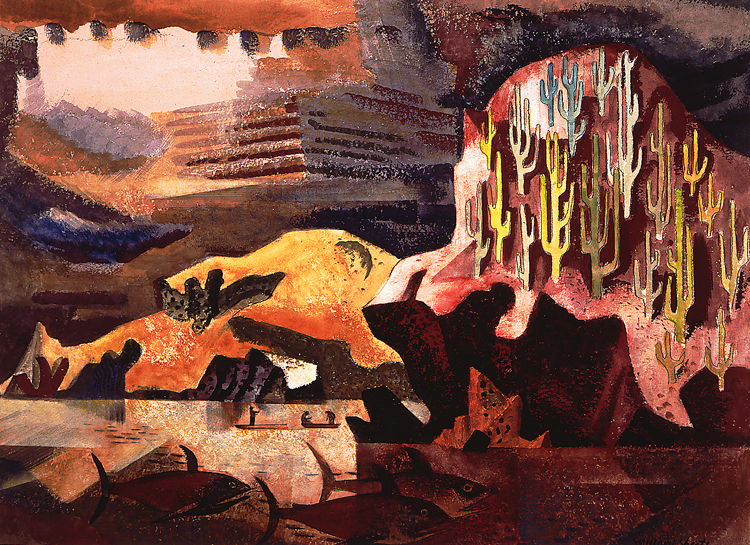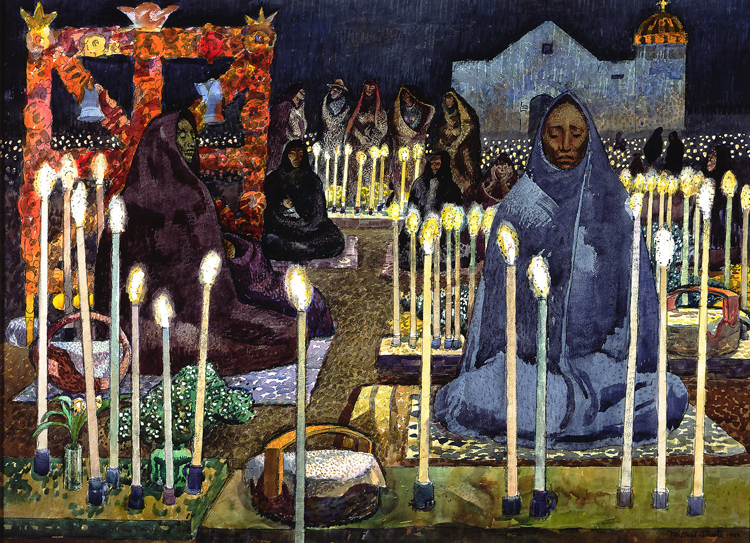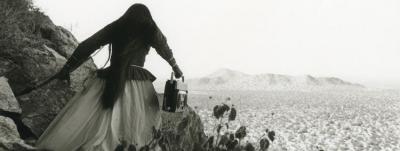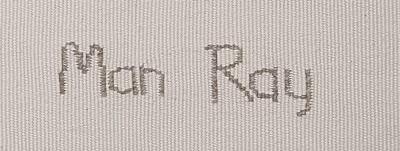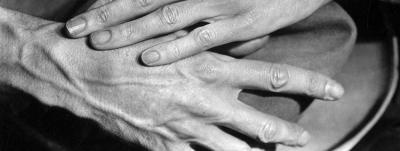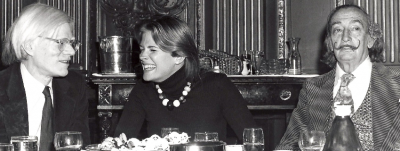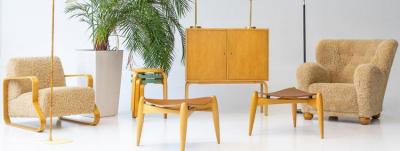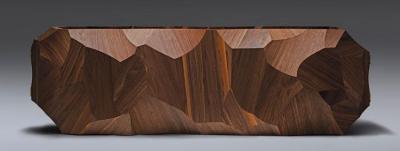Travels with Millard Sheets, 1950–1986
From the E. Gene Crain Collection
In 1982, Millard Sheets (1907–1989) remarked "The beauty and dignity of people who are truly adjusted to their way of life fills me with respect and awe." Sheets had enormous respect for people from other cultures, and that respect is reflected in his works. He made his first international trip in 1929 when he was just twenty-two years old. He embarked for Europe on a freighter that was scheduled to stop at seventeen ports on its way from Los Angeles to New York via Central and South America. At every port, Sheets would get off and sketch and paint, mostly in watercolor. This was his first lesson in quick painting and sketching in exotic locales. After six months in Europe, Sheets returned to California.
During the 1930s, when Sheets was actively pursuing a career as an artist, teacher, and educator, his trips were limited to nearby destinations; the only locale that was “exotic” was Mexico. He also spent a few summers teaching and painting in Hawaii. In the early 1940s, during World War II, he was contracted by Life magazine as an artist-correspondent. Assigned to the China-Burma-India front, he spent several months in India during 1943 and 1944. He saw the country under extremes, from the devastation of the worst famine in its history to the remarkable beauty of its land and its historical sites and architecture. He vowed sometime in the future to return to India under better circumstances.
Several years after returning from the war, Sheets began traveling worldwide. From 1950 to 1985, he visited over thirty countries in various professional capacities. In 1950, he moved to Hawaii for a year’s sabbatical and it became one of his favorite locales. Two of his most important trips were made in 1960 and 1961 when, as an American Art Specialist for the United States Department of State, he was sent to Turkey and Russia (then the Soviet Union). It was during these trips that he was able to put into place his goal for finding a common ground with people from other cultures through art.
Accompanied by his wife, Mary, he spent January through March 1960 in Turkey. He gave many lectures on art and architecture and did some outdoor painting demonstrations, although difficult because of the bitter cold. Traveling by car, they logged over 3,000 miles throughout the country and along the Mediterranean coast.
The success of his trip to Turkey led to his being asked to go to Russia the following year. Although the United States and the Soviets were in the throes of the cold war, the artist was treated with a great deal of respect and accorded fine accommodations with rooms spacious enough to allow him to paint. Sheets visited artists’ studios and the artists’ union (or guild), giving about seventeen lectures in the course of just a few weeks. He found the Russian people to be surprisingly well informed about modern art, but eager to learn whatever they could about American art and architecture.
When not lecturing, Sheets and his wife traveled in Moscow and Leningrad as much as they were allowed, as well as to Armenia and to the exotic cities of Tashkent and Samarkand in Uzbekistan. They also visited the seven temples in the ancient walled city of Zagorsk, which was still a training center for Christian clergy. It was a remarkable journey, one that would remain in the artist’s mind for years to come.
Travel was now an integral part of Sheets's career. In 1966, he was contracted by Thurman and Bud Hewitt to conduct a painting workshop they organized in San Miguel Allende, Mexico. Over the next nineteen years, Sheets hosted workshops for the Hewitt brothers in many foreign countries, including Greece, Japan, Thailand, Nepal, Hong Kong, India, Mexico, Ireland, Yugoslavia, Tahiti, Moorea, Fiji, New Zealand, France, Spain, Portugal, Hawaii, China, and Egypt. In 1967, he went around the world, departing from Los Angeles to Hawaii, then to Japan, Hong Kong, Thailand, India, Lebanon, Greece, and London before returning to Los Angeles. In 1984, at the age of seventy-seven, he conducted two workshops back-to-back, in India and Hong Kong.
Sheets had learned from his very first trip in 1929 that watercolor was the perfect medium for a traveling artist. The quickness of the medium, its portability and rapid drying ability enabled the artist to record a scene in a minimum amount of time. He usually transported about fifty pounds of equipment on his long trips—paper, paints, brushes, easel, etc. When painting was difficult he would sketch; once home, his sketches would provide material for paintings for years to come.
Certainly, there were favorite places—Mexico, Tahiti, and West Africa. His trip to West Africa in February 1979 was followed by the publication of Mary Sheets’s A West African Journal. She wrote: "Millard was overwhelmed by the incredible beauty of the Africans, the infinite variety and richness of their garments, the excitement and the dazzling color of the teeming markets, the stunning architecture of the sculptured mosques, and the simple elegance of the mud villages. He knew that he could get wonderful material for his painting, unlike anything he had found on other travels.” The trip was exceedingly difficult. In contrast to the elegant accommodations that they had received in Russia, often the rooms in West Africa were inadequate, sparse, and dirty, and travel was laborious and uncomfortable. Nevertheless, Mary recalled: "The hardships and frustrations we had encountered were real and often trying but the moments of beauty and wonder during those crowded days far outweighed the brief miseries.”
In 1983, Sheets was honored with a retrospective exhibition at the Laguna Beach Museum of Art. Nearly half of the ninety-eight paintings were of other countries. Many years before, a writer in Time magazine remarked that Sheets's works looked a little like illustrations for a travel folder, yet with "dash . . . and unmistakable crowd appeal.” And what a travelogue it is! The viewer is able to experience Sheets’s world, through his keenly perceptive and sensitive artist's eyes, a world filled with color and pattern and form beyond what the ordinary person would experience. Sheets's works are what he would call abstract representations. “Abstract design is fundamental to the representational painter. There should not be a quarrel between abstraction and representation. Abstraction has given the mind back to the artist.”
Through closer observation of Sheets's work, we see the strength of his interpretation and the essential elements of design and abstraction that he utilizes. His experience as a designer of murals and tapestries is evident in such paintings as The African Fon in Procession (Fig. 1) and Surf Riders, Mazatlan (Fig. 2). The compositions are deliberately flat, with decorative motifs like a mosaic pattern. An especially intriguing form is the serpent-like cloud pattern in the distant hills and sky in Surf Riders, Mazatlan.
Sheets always aspired to push the watercolor medium to its full range of possibilities, from luminous transparency to a textured opacity achieved with multilayered washes and pointillist-like technique. Each setting called for a particular interpretation in order to communicate the mood. Movement and activity is something Sheets also liked to express in his works. The constant movement of people in India, Mexico, and Africa was something he remarked upon and attempted to capture in his works.
Throughout his career, Sheets kept a constant vision of the world that was only briefly shaken by his war experiences. The late Lawrence A. Fleischman, Director of Kennedy Galleries in New York, said in 1982:
He is a reflective and articulate artist, someone truly adjusted to his world and able to find in it an inexhaustible font of inspiration for his creative energies. An abiding optimism that characterizes whatever he does is reflected in the lyrical quality of his paintings. Their rhythmic configurations, vibrant colors and harmonious designs converge into clearly defined images of glowing appeal.
The critics discovered these qualities with his first public exhibition in April 1929. [A] "joyful and buoyant response to the picturesque aspects of life . . . an ever-present decorative faculty . . . and a feeling for beautiful, luminous color”—we saw it then, and we see it today.
—
What: Travels with Millard Sheets: 1950–1986
Where: Laguna Art Museum, 307 Cliff Drive, Laguna Beach, CA
When: February 23–June 1, 2014
Contact: lagunaartmuseum.org or 949.494.8971
—
Janet Blake is curator of historical art, Laguna Art Museum.



















